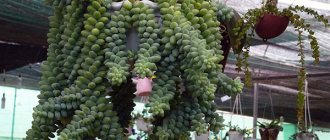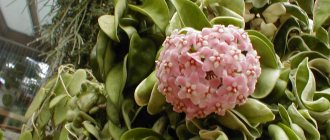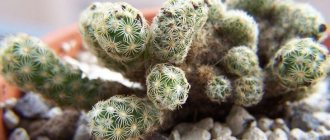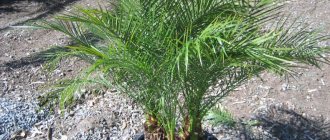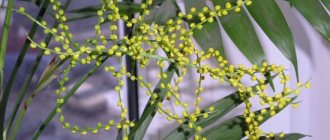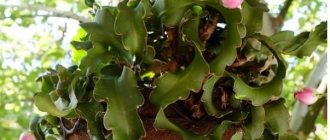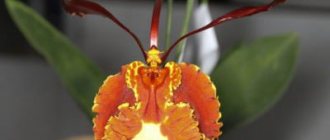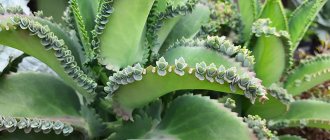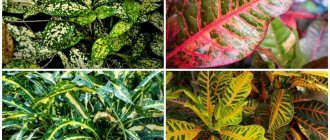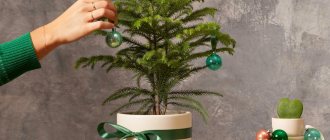The main advantages of Haworthia
If necessary, Haworthia can go without water for up to several weeks, without forcing you to rack your brains about who to entrust watering to during the holidays.
Thanks to this, it is an excellent idea for a gift that does not burden the recipient, because it is suitable for both home and office, and is able to endure long separations from a person without compromising its well-being.
In addition to being a very convenient houseplant, Haworthia boasts a huge number of different varieties. To all the other positive qualities of Haworthia, another bonus is that it is not poisonous to people or animals.
Transplanting a plant step by step
The plant should not be replanted often, as it grows slowly. In the Haworthia standard, the pot is changed every 2-3 years or even less often.
- Carefully remove the flower from the old pot so as not to damage the weak surface roots.
- Clean the root from the soil and, if desired, treat it with a weak solution of fungicide.
- In a new container, cover the drainage area to about 1/3 of the volume.
- Plant the bush and cover it with soil without compacting it.
- Place the plant for 10-15 days in a bright place and shade it from direct sun.
A signal that this succulent already needs replanting is usually the drying tips of the leaves.
Growing conditions
Haworthia will perfectly withstand a long independent existence if it is in an acceptable room temperature (from + 10 to + 29 degrees Celsius), not in direct sunlight, in a room where there is ventilation, and it is watered regularly (at least once every two weeks).
These plants easily adapt to moving and tolerate various lighting conditions well, but not direct sunlight or deep shade. In direct sunlight, the haworthia leaves gradually turn unsightly red, purple or brown, and then the flower dies.
If you move it to a more shaded place in a timely manner, and the process of changing the color of the leaves has not gone too far, Haworthia will be able to return to its original appearance.
Deep shadow gradually and imperceptibly weakens the plant. Haworthia becomes pale green, loses its original “pearl” seals and markings and its compact shape, and begins to stretch out, as if trying to find the sun's rays somewhere above.
At the first suspicion of a negative effect of shade, you should add light to the plant - but just do not leave it in direct sunlight.
Home species with photos and descriptions
Haworthia is a herbaceous succulent native to South Africa from the Asphodelaceae family. The plants received their name thanks to the scientist Adrian Hardy Haworth Haworth, who was the first to study the species and compile descriptions of succulents.
There are three species groups based on the shape and structure of the leaves:
- Window;
- Stiffleaf;
- Herbaceous.
More than 150 varieties of Haworthia grow in their natural habitat. They differ in the shape of the leaf blades, color and other characteristics. Looking at the diversity of species, it is difficult to imagine that all plants belong to the same genus, species and family.
Photo taken from Georgy Aristov’s website https://raritet-plants.ru/
The most popular varietal varieties:
- Variegata;
- Obtusa;
- Multiflora;
- Dielsiana;
- Paradoxa;
- Sublineata;
- Pumila;
- Truncata.
Thanks to the work of breeders, new domestic varieties appear every year that take root well in apartment conditions.
Haworthia (H. fasciata)
This is a slow-growing species that rarely exceeds 10 cm in domestic conditions. The rosettes are dense and consist of hard elongated leaf blades. The leaves are triangular, dark green with white horizontal stripes. Flowering is rare, but with good care the succulent produces a long flower stalk from October to November.
The length of the peduncle can reach 15 cm. The buds are small, shaped like bells, and the color is white or yellowish. Striped Haworthia does not require special care; this species should be hidden from direct sunlight and frequent watering should be avoided.
Pearl Haworthia (H. margaritifera)
An interesting variety, which is considered one of the largest among Haworthias. The leaf blades are semi-oval with a pointed end. The inner part of the leaf is flat, dark green in color, the outer part is convex with white growths “pearls”.
The width of the leaves is from 2 to 3 cm, the length is from 6 to 10 cm. The leaves are collected in a dense rosette, there is no stem. In spring, the plant produces a peduncle 40 to 60 cm long; small green-white buds form on it.
Haworthia navicular or cymbiformis (H. cymbiformis)
Haworthia cymbiformis var.
obtusa Haworthia navicularis takes its name from the shape and structure of its leaves. The succulent forms many rosettes of boat-shaped leaf blades. The height of adult specimens is no more than 10 cm, and the width is limited by the size of the pot.
The leaves are fleshy, soft to the touch, light green in color. There are varieties with dark leaves with light green or white stripes. It does not bloom often, usually in spring. It produces one peduncle, on which 3 to 6 inconspicuous flowers are formed.
Haworthia Cooper (H. Cooperi)
Haworthia Coopera is an amazing succulent with dense, fleshy leaves of a rich green color with dark veins and transparent windows. The leaves are from 5 to 8 cm long, semi-oval in shape with a slightly pointed edge that bends into the rosette.
Along the edges of the leaf blades there are thin, short cilia. During flowering, it produces a peduncle with 2-7 greenish-white buds.
Also read: Agave: main types grown at home and caring for them
Haworthia limofolia or limophila (H. limifolia)
Haworthia limifolia var.
striata Haworthia Limifolia Variegata This variety cannot boast of large size. At home, the height of the spiral-shaped rosettes is no more than 12 cm. The leaves are triangular and pointed. The main color is dark green or lemon yellow.
In green varieties, the edge of the leaf has a yellow tint, and in lemon varieties (Limifolia Variegata) there are dark green, vertical stripes in the center or along the edges of the blade. The inflorescences consist of small white buds.
Haworthia blunted or Retuza (H. retusa)
The succulent got its name from the blunt shape of its leaves. The height of an adult plant is no more than 15 cm, one leaf reaches a length of 2 to 3.5 cm. The base of the leaves grows upward, and the edge bends outward and forms a three-dimensional triangle. The color of the plates is dark or light green.
Under intense light, the color changes to red-green. The rosettes are dense and densely spaced. It blooms rarely, peduncles form in the spring. From 5 to 10 small flowers can grow on one stem.
Haworthia truncata (H. truncata)
H. TRUNCATA “LIME GREEN”
Haworthia truncata differs significantly from other species. This miniature perennial forms dense longitudinal rosettes of flattened, rectangular leaf blades with chopped tips. In appearance, the succulent resembles dominoes stacked one after another.
Plant height is up to 10 cm, leaf width is from 2 to 2.5 cm, length is from 3 to 6 cm. Variegated forms are valued among breeders, but they are quite difficult to grow.
Haworthia cobweb (H. Arachnoidea, Papierrosie, Spinnekopnes)
An unpretentious herbaceous plant that even a beginner can handle. It differs from other varieties by white, long bristles that densely dot the leaf blades. The leaves are pointed, elongated, green in color. An adult plant is round in shape, about 6–8 cm high. It practically does not bloom at home.
Haworthia pentagonal or Pentagon (H. Pentagona)
Quite a large variety with dense, fleshy leaf blades, dark green in color. Height is from 5 to 20 cm, rosette diameter is from 10 to 15 cm. The succulent looks like aloe, but grows much faster.
Lateral growths appear annually; if the children are not replanted, they quickly fill all the free space. This haworthia, unlike others, can form a low stem.
Haworthia Emily (H. Emelyae)
Haworthia Emelyae Picta
Low succulent from 5 to 8 cm, triangular-shaped leaf blades up to 5 cm in length. The color of the leaves is olive green with contrasting dark veins, depending on the type with white inclusions or small spines.
During drought or at low temperatures, the veins turn red. In spring it produces a peduncle 25 to 45 cm in height, on which 3 to 6 white flowers are formed.
Haworthia Baera or Laeta (H. Bayeri, Laeta)
Haworthia Baera has an original coloring of leaf blades. The main color of the leaves is light green or red. The veins on the upper part of the plates are arranged chaotically (in a grid) and are colored pink and white.
Some varieties have a glossy, “glass” surface, others have a rough surface. In spring or summer, the succulent produces an arrow, 20 to 30 cm high. Many white buds form at the top of the peduncle.
Haworthia Odetteae (H. Odetteae)
Haworthia odetteae De Rust
The height of an adult bush is no more than 10 cm; its distinctive feature is thin “needle-like” leaves, densely covered with white fibers from base to tip. The root system is delicate and thin.
It is considered a rare variety, as it produces few growths, and the seeds rarely appear on the open market. Quite whimsical, does not tolerate shortcomings in care. Does not bloom at home.
Haworthia tortuous (H. tortuosa)
This variety forms a pyramidal rosette of dense, triangular leaf blades. The lower leaves are larger; the closer to the central part, the smaller they are.
The color of the leaves is grayish-green or dark green. On the outer side of the plates there are warty protuberances. Height from 10 to 20 cm. The flowers are small, pink, white or greenish in color.
Haworthia spinosa or aristata (H. Aristata)
Adult specimens are round in shape, up to 10 cm high. The leaf blades are wedge-shaped with a wide base and a pointed edge. The color is dark green, along the edges and on the outside of the spine leaves. As they mature, the tips of the leaves become reddish in color.
Also read: Choosing succulents for planting in the ground in the garden
Haworthia (H. Attenuata)
Haworthia attenuata f.
tanba In appearance, the retracted haworthia resembles the pearl one, but its warts are less pronounced. The entire inner and outer side of the leaf blades is simply dotted with small white or light green dots. The main color of the leaves is rich green, some varieties have a red tint.
The plates are wide at the base and evenly taper towards the tip, lanceolate in shape. The flowers are small, pale white. The diameter of the rosette is from 6 to 12 cm.
Haworthia Reinwardtii (H. Reinwardtii)
The appearance of the leaves resembles pearl, but grows vertically. The rosette is formed from lanceolate leaves of the same size, dark green in color with white warts. In intense light a reddish tint appears. Adult succulents reach a height of 10 to 15 cm. The leaves fit tightly to the base, making the haworthia look like a small tower.
Haworthia sticky or viscose (H. Viscosa)
The vertical rosette reaches sizes from 10 to 20 cm and consists of leaves arranged in rows of 3 pieces. The leaf blades are wide, swollen at the base, sharply tapering towards the tip, triangular in shape. The outer side is convex, the inner is concave. The main color is light green, sometimes the tips become reddish in color.
Black Haworthia (H. Nigra)
Photo source: succulent.com.ua
Differs from other varieties in the dark color of the leaves. The plates are dark green, almost black, growing two in a row, one above the other or in a spiral. The rosettes are small, from 3 to 6 cm in diameter, height no more than 10 cm. The leaves are triangular in shape, the outer part is curved, the inner part is concave.
The tubercles are well defined, colored in the main color. During flowering, the plant produces a peduncle with whitish flowers.
Haworthia Maughanii (H. Maughanii)
An original variety with cylindrical leaves. The lower part is opaque and colored dark green, pinkish, light green, orange or white. There are striped varieties. The upper part of the leaves (windows) is almost transparent. During flowering, it forms several flower stalks from 5 to 10 cm in height; the flowers are small, white or pinkish in color.
Haworthia chessboard (H. tesselata)
Rosettes are from 5 to 8 cm in diameter, from 3 to 9 cm in height. The leaf blades are dense, jagged, tapered to the tip. The outer side is covered with warty growths, the inner side is painted with a mesh of contrasting stains.
The main color is reddish or green, the mesh is lighter or darker depending on the variety. During the flowering period, the succulent produces a peduncle on which small buds of pinkish or white color are formed.
Watering – easy and infrequent
Not the most difficult question is how to water a Khavrotia flower, because it quite patiently waits for the next portion of moisture.
In order for it to simply survive, it is enough to water the plant once a month, but if the goal is its prosperous existence, it requires watering at least once every two weeks, and possibly once a week - if the ambient temperature is constant above 25 degrees Celsius.
Haworthia, which tolerates heat well, quickly dies if overwatered. When watering it, you should make sure that the water does not flood the crown or inflorescence - at low temperatures, excess moisture can contribute to irreversible rotting of these parts of the flower.
How Haworthia blooms
As a rule, flowering time occurs at the end of spring or the first days of summer.
The flowering of Haworthia itself is very inconspicuous and fleeting. The plant throws out one long peduncle, on which small, most often white flowers appear. Haworthia can grow from 5 to 20 years, even indoors, but it can bloom only once.
But in any case, the main decorative feature of Haworthia is always its beautiful and extraordinary leaves. Most gardeners grow the flower precisely because of the unusual appearance of the bush, and in order not to waste the plant’s energy on frankly inconspicuous flowering, they cut off the peduncle as soon as it begins to appear.
Humidity and fertilizing
As a rule, succulents do not particularly care about the level of humidity in the room, but they do like good ventilation, so you should avoid overly cramped and “airless” corners of your home or office for placing Haworthia.
You should not feed your haworthia with fertilizers too often; in addition, you must always make sure that the prepared solution is not too saturated.
Homeland of the plant and structure
This flower is found in the south, southwest and southeast of Africa. In nature, the succulent prefers to settle in dry places: savannas, on the slopes of mountains and hills. In the wild it can even reach 1 m in height, while indoor varieties barely grow to 15-25 cm and even one of the “technical” characteristics is almost imperceptible growth.
Haworthia is a plant with a rosette of leaves in the above-ground part. They can be colored green, brick, and in some varieties, orange-red. And it is obvious that the main decorative effect lies precisely in the leaves. They are found in triangular, elongated, pointed and rounded shapes. The edges are decorated with frequent teeth or elongated cilia, reminiscent of fluff or cobwebs. And most varieties have pleasant-to-touch growths-tubercles of different colors along the entire length of the leaf blade.
The root system develops mainly to the sides. There, over time, individual young bushes form, which grow most actively after the death of the mother bush.
In the wild, Haworthia blooms annually, throwing out a long peduncle in the central part with inflorescences of small and rather inconspicuous flowers. Flowering indoors is not difficult to achieve, but most often it occurs only once during the entire life of the bush.
Temperature
Haworthia is quite suitable at normal temperatures, even in an unheated room, which lasts from spring to autumn. In winter, even if additional heating is turned on, it will withstand it as much as a person can withstand it.
If we are not talking about a Russian stove or Haworthia is not standing on a radiator, any temperature regime will be comfortable for this plant.
Pests and diseases
Haworthia is not damaged by diseases, except for rot caused by improper watering. If you allow liquid to stagnate in the substrate and water the plant with cold water, the roots will soon begin to rot.
Catching the disease in its early stages is difficult. When the rosette withers, the roots will already be dead. You can save the plant by rooting still healthy leaves.
Perennials can be attacked by aphids and root worms. Parasites can be introduced into a home flower garden with new plants and poorly disinfected soil.
Aphids gather in colonies on the leaves, sucking out the juice, causing the leaves to wither and dry out. They get rid of the pest by treating the plant with Actellik, Aktara, every 12 days until the parasite is completely destroyed.
The root mealybug is invisible because it is a parasite in the soil. The leaves of the affected plant turn red and a whitish coating appears on the soil. Haworthia should be transplanted into a clean substrate, after soaking the roots in a Fitoverm solution.
Transplantation and vegetative propagation
Haworthia does not quickly “grow” out of its pot, so it will not need replanting very often. Young plants are replanted approximately once a year, and grown ones - no more than once every three years.
If the time has come to replant it, it is necessary to use a soil composition similar to that in which Haworthia was previously located. Typically, neutral soil is used for these purposes with the addition of sand or perlite to improve the drainage process.
If you divide the plant after transplanting using cuttings, you can reuse the existing pot. When replanting completely, simply select a pot slightly larger than the previous one.
For cuttings, a sharp knife is used; the cuttings of the new Chavrotia are cut close to the main (mother) plant. You should also make sure that the plant being separated has roots.
Sometimes a knife is not necessary, as the detached plant resembles a loose tooth and comes off naturally with a slight tug. The jerk should be done carefully, trying not to damage the main plant.
You need to wait a day until the cuttings dry out a little - this will reduce the likelihood of the untreated “wound” rotting when added to compost.
It is then placed in a small pot using standard succulent soil, watered and placed in a fairly warm place. Transplantation and cuttings are preferably carried out in late spring.
All healthy plants will eventually produce flowers; any Haworthia usually blooms in summer or late summer. The absence of flowers in an adult (3+ years) plant may signal the need to reconsider the method of caring for it.
Possible problems
Beginning gardeners often make mistakes when caring for their pets. The plant signals about improper care by a changed appearance.
| Yellow spots appeared on the leaves | This is a burn from too much sun. Plants must be shaded with white lutrasil or a tulle curtain |
| The leaves are drying up | The air is too hot and dry. There is no need to spray the haworthia, but you can place a plate of water next to the pot to increase air humidity. |
| Leaves become soft and flabby | Either infrequent watering or too much moisture in the substrate. |
| Succulent growing slowly | Poor soil, little fertilizing. |
Seeds or cuttings?
Vegetative propagation when growing Chavrotia at home is the fastest and most reliable way to get this plant into your home.
However, some indoor gardening fans prefer to grow their plants from scratch and only from seeds. In the case of Chavrotia, their viability begins to steadily decline about a year after harvest.
You should buy only fresh seeds, and decent sellers should indicate the harvest season and the most preferred methods and time for starting to grow seedlings in a particular region.
By purchasing Haworthia, a home gardener will receive a grateful and patient plant that will always “get into position” and wait for its portion of water, light or fertilizing - only for this can you love it with all your heart.
Reproduction methods
Haworthia is propagated using daughter rosettes (babies), leaf cuttings and seeds. Basically, the first two methods are used, since the seed material is poorly stored, and six months after collection the seeds are no longer viable.
Children
Transplantation is most often carried out in the spring, and it is very convenient to separate the children at this moment - you do not have to injure the plant again. It should be divided when the root system of the children is formed.
After dividing, the young rosettes are planted in separate, small-sized cups, watered and kept in a warm, shaded place for a week, then exposed to bright light, but without direct sun. When the seedling takes root, you can transplant it to a permanent place.
Cuttings
When propagated by cuttings, all the characteristics of the mother plant are preserved, and this method is used most often, since not all species produce offspring. Separate the cutting (leaf) from the mother plant by twisting or cutting, using a tool. The wound on the socket must be sprinkled with coal powder and treated with a fungicide.
Planting stages:
- the cuttings are kept in the air for several days - the cut should dry out;
- before planting, the cut site is treated with powdered coal, then with a root growth stimulator;
- the leaf is planted in a moistened substrate (equal parts of sand and perlite), deepened by 1 cm;
- the glass with the cutting is placed in a warm, bright place, protected from the bright sun;
- water rarely, moderately;
- When young shoots appear, transplant them into a small container.
Seeds
If you decide to propagate by seeds, then they should be planted in early spring, given that the plant will develop slowly and most of the seedlings will die. For growing seedlings, a low container is suitable, at the bottom of which a layer of drainage (1.5-2 cm) is poured, and a loose substrate is placed on it. The seeds are evenly laid out on the surface of the moistened substrate, sprinkled with sand (you don’t need to cover it) and the container is covered with film or glass.
The seed method of propagation does not guarantee the inheritance of the characteristics of the parent plant.
Germination requires warmth and light, so the container is placed in a warm, bright place, but not in bright sun. The film must be opened slightly daily to remove condensation. Germination occurs unevenly, so the greenhouse is removed after most of the seeds have germinated. Picking is carried out after 5-6 months.
Compact, low Haworthias can be grown as individual plants, or as part of a composition made up of representatives of the genus; they grow well in florariums. The miniature size allows you to assemble a collection of different types of exotic original plants in a small area.
Photo of Haworthia plant
Haworthia: features of planting and care (video)
Mosaic
Checkerboard haworthia, as it is also called, is an almost stemless plant that forms a basal rosette with very pretty leaves. The spiral arrangement, interesting shape and pointed edges, outward curve and incredible pattern on the surface are the main distinguishing qualities of a plant that will decorate your “window garden” very simply.
A huge number of Haworthia species can be looked at for hours, and not only because of the large number, but also because succulents are very attractive and the time of studying them flies by.
In addition to the several species we have indicated, we suggest you pay attention to others, no less interesting: Haworthia Sticky, Limofolia, Reinwardta, Pearl, Terkovidnaya, Cobweb-shaped and others.
By carefully studying each species, you will be very surprised, since some plants are so different from their relatives that it is even impossible to attribute them to a single class right away.
Problems in keeping haworthia and ways to eliminate them
In the absence of proper care, unpleasant phenomena occur. They can be eliminated by adjusting the content:
| Problem with leaves, etc. | Cause | Elimination methods |
| Sluggish to the touch. The plant is stretched. | Lack of light. | The pot is moved to a well-lit place, fed with any purchased mixture for cacti and succulents. |
| They curl into a spiral and dry out at the ends. | Cold, perhaps the plant is in a draft. | The pot is moved to another place, protected from drafts. |
| Turn yellow or red. | Excess fertilizer, especially phosphorus-containing mixtures. | Review the feeding regime. |
| They wrinkle, become covered with brown spots, and darken. | Burn. | Affected leaves are removed. The plant is shaded. |
| Soft, watery, shapeless. | Excessive moisture. | Watering is stopped for 2 weeks. |
| Dark and rotten. |
| Move to a warm place, reduce the amount of watering. |
| They stretch out, bend, the pattern blurs. | It's hot inside. | The pot is transferred to a cool room. The room is ventilated more often. |
